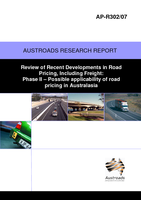Freight

Review of Recent Developments in Road Pricing, Including Freight Phase 2: Possible applicability of road pricing in Australasia
- Publication no: AP-R302-07
- ISBN: 1 921139 90 0
- Published: 24 January 2007
- PDF (free) Download
This report provides an analysis of road pricing from a technical perspective to inform road authorities in Australia and New Zealand of some of the key issues involved. A key objective is to provide advice on what is required to identify and analyse road pricing options and their deliverability in an Australasian context. Three generic pricing mechanisms are selected for more detailed investigation; cordon pricing schemes, link/network pricing schemes and HOT lane schemes. Several comparative examples under each of the three pricing mechanisms have been discussed to draw useful lessons and raise the debate about what may be appropriate for major Australasian cities. The generic pricing schemes analysed can pave the way for network-wide schemes that enable a variety of key objectives including pricing of externalities (e.g. congestion, emissions, and pavement and bridge wear). New pricing based measures can be brought to bear when traffic congestion is severe enough and clear policy objectives are articulated by government.
- AP-R302/07 Review of Recent Developments in Road Pricing, Including Freight: Phase II – Possible applicability of road pricing in Australasia
- Austroads membership
- 1. INTRODUCTION
- 1.1. Key issues and findings of Phase I
- 1.2. Objectives and direction of Phase II
- 1.3. Structure and scope of this report
- 2. A PERSPECTIVE OF ROAD PRICING
- 2.1. Road transport context
- 2.2. Definition of road pricing
- 2.3. Current experience with road pricing mechanisms
- 2.4. Road pricing mechanisms used in urban areas
- 2.5. Road pricing mechanisms - some implications
- 2.6. Road pricing benefits
- 3. SELECTION OF ROAD PRICING CASE STUDIES
- 3.1. Case study 1: Cordon pricing mechanisms
- 3.2. Case study 2: Link/network tolling
- 3.3. Case study 3: High occupancy toll (HOT) lanes
- 4. CONCLUDING STATEMENTS
- REFERENCES
- The passenger task
- The Freight Task
- Inter-capital freight transport
- Urban freight transport
- The rail transport task
- The road transport task
- The freight task
- The rail freight task
- Petrol Tax
- Road user charges
- Toll charges
- Revenue from the rail task
- London
- Edinburgh
- Norway (Trondheim)
- New Zealand (Auckland)
- New South Wales (Sydney)
- London
- Edinburgh
- Other UK towns
- New South Wales (Sydney)
- Cordon pricing
- Electronic road pricing (ERP)
- Parking space levies (PSL)
- Norway (Trondheim)
- Household survey
- Business survey
- Revenue impacts
- United Kingdom
- Hong Kong
- Cross Harbour Tunnel and Eastern Harbour Crossing
- Tate’s Cairn Tunnel
- Western Harbour Crossing
- Route 3 Country Park Section
- Hong Kong
- New Zealand (Auckland)
- Australia
- Europe
- Revenue impacts
- Twin Cities HOT lane trial on Route I-394
- HOT/HOV demonstration project on Interstate 15 in San Diego, California
- Assessment of HOT lane usage and network performance on Interstate 35 (I-35W) in Fort Worth, Texas
- Demand
- Pricing
- Carpooling
- Time window for matching carpooling
- Pricing and HOT lane access configuration
- Carpooling attractiveness
- Time window for matching carpooling
- Twin Cities I-394 HOT lanes project
- I-35W HOT lanes study
- Determinants of location of HOT lanes in terms of the California Partners for Advanced Transit and Highways (PATH) Project
- Cordon pricing
- Electronic road pricing (ERP)
- Parking space levies (PSL)
Related publications
WEB-AP-R677-22
Latest Freight News
